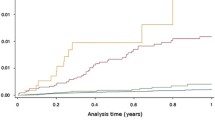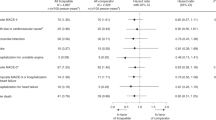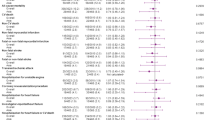Abstract
Background: Obesity is a serious and rapidly growing health problem worldwide. Few therapies are available beyond diet, exercise and bariatric surgery. A previously approved medication, sibutramine, has been withdrawn from the market due to concerns over the potential of increased risk of cardiovascular (CV) events, based on a phase IV clinical trial that included only individuals at high risk for CV events.
Objective: The aim of the study was to compare sibutramine users and matched non-users on rates of CV events, both overall and stratified by whether the patient qualified for on-label sibutramine use, using data from real-life clinical practice.
Methods: A retrospective cohort was constructed from electronic medical record data from physician office practices (mostly primary care) in the UK and Germany, using the LifeLink™ database from IMS Health Incorporated. For patients with at least one physician visit in which sibutramine was prescribed between 1 April 1999 and 31 October 2008, the date of their first such prescription was their index date. Users and non-users were matched 1:1 on index date (within 30 days), sex, age group (six categories), Charlson Comorbidity Index and evidence of obesity (high body mass index [BMI] or, if BMI was missing, diagnosis of obesity or very high weight relative to height). The resultant total samples analysed were 6186 in Germany and 7264 in the UK. User and non-user cohorts in the samples were compared according to the ratio of their crude incidence rates of acute myocardial infarction (AMI), stroke and either AMI or stroke per 1000 patient-years of follow-up. Cox regression analysis was used to compare the risk of CV events as a hazard ratio (HR) with 95% confidence intervals (CIs) between sibutramine user and non-user cohorts, controlling for label status and/or history of prior CV disease at baseline.
Results: The risk of AMI, stroke and either AMI or stroke was not higher among sibutramine users than comparable non-users of sibutramine in both Germany and the UK [Germany: HR 0.47 (95% CI 0.17, 1.26), 0.43 (0.23, 0.81) and 0.44 (0.26, 0.75), respectively; UK: HR 0.44 (0.15, 1.31), 0.63 (0.25, 1.60) and 0.54 (0.27, 1.10), respectively]. Regardless of whether or not the model controlled for prior CV disease (CVD), the direction and statistical significance of the differences did not change. In the sensitivity analyses including only those without a history of CVD in the 365 days prior to the index date there was no increased risk of CV events in either Germany or the UK.
Conclusion: This study offers a framework for the safety assessment of anti-obesity drugs using an observational epidemiological study design. Large electronic health databases were used to construct retrospective cohorts to examine the risk in a population using one specific anti-obesity drug. Use of sibutramine in general practice settings was not found to increase the risk of acute CV events.






Similar content being viewed by others
References
James PT, Rigby N, Leach R. The obesity epidemic, metabolic syndrome and future prevention strategies. Eur J Cardiovasc Prev Rehabil Feb 2004; 11(1): 3–8
Guh DP, Zhang W, Bansback N, et al. The incidence of comorbidities related to obesity and overweight: a systematic review and meta-analysis. BMC Public Health 2009; 9: 88
Padwal RS, Sharma AM. Prevention of cardiovascular disease: obesity, diabetes and the metabolic syndrome. Can J Cardiol 2010 Aug–Sep; 26 Suppl. C: 18–20C
Saavedra LE. Endocannabinoid system and cardiometabolic risk. Clin Pharmacol Ther 2007 Nov; 82(5): 591–4
Ogden CL, Yanovski SZ, Carroll MD, et al. The epidemiology of obesity. Gastroenterology 2007 May; 132(6): 2087–102
Nguyen DM, El-Serag HB. The epidemiology of obesity. Gastroenterol Clin North Am 2010 Mar; 39(1): 1–7
Bray GA, Ryan DH, Gordon D, et al. A double-blind randomized placebo-controlled trial of sibutramine. Obes Res 1996 May; 4(3): 263–70
James WP, Astrup A, Finer N, et al. Effect of sibutramine on weight maintenance after weight loss: a randomised trial. STORM Study Group. Sibutramine Trial of Obesity Reduction and Maintenance. Lancet 2000 Dec 23–30; 356(9248): 2119–25
European Medicines Agency, Committee for Proprietary Medicinal Products. Opinion following an article 31 referral. Sibutramine: background information [online]. Available from URL: http://www.ema.europa.eu/pdfs/human/referral/sibutramine/451402en.pdf [Accessed 2010 Jun 22]
Caterson I, Coutinho W, Finer N, et al. Early response to sibutramine in patients not meeting current label criteria: preliminary analysis of SCOUT lead-in period. Obesity (Silver Spring) 2010 May; 18(5): 987–94
James WP, Caterson ID, Coutinho W, et al. Effect of sibutramine on cardiovascular outcomes in overweight and obese subjects. N Engl J Med 2010 Sep 2; 363(10): 905–17
Maggioni AP, Caterson I, Coutinho W, et al. Tolerability of sibutramine during a 6-week treatment period in high-risk patients with cardiovascular disease and/or diabetes: a preliminary analysis of the Sibutramine Cardiovascular Outcomes (SCOUT) trial. J Cardiovasc Pharmacol 2008 Nov; 52(5): 393–402
Caterson ID, Finer N, Coutinho W, et al. Maintained intentional weight loss reduces cardiovascular outcomes: results from the Sibutramine Cardiovascular OUTcomes (SCOUT) trial. Diabetes Obes Metab 2012; 14(6): 523–30
Padwal R, Li SK, Lau DC. Long-term pharmacotherapy for obesity and overweight. Cochrane Database Syst Rev 2004; (3): CD004094
Scheen AJ. Cardiovascular risk-benefit profile of sibutramine. Am J Cardiovasc Drugs 2010; 10(5): 321–34
Greenland S, Morgenstern H. Matching and efficiency in cohort studies. Am J Epidemiol 1990 Jan; 131(1): 151–9
Romano PS, Roos LL, Jollis JG. Adapting a clinical comorbidity index for use with ICD-9-CM administrative data: differing perspectives. J Clin Epidemiol 1993 Oct; 46(10): 1075-9; discussion 1081–90
Bowker AH. A test for symmetry in contingency tables. J Am Stat Assoc 1948 Dec; 43(244): 572–4
Pearson K. On the criterion that a given system of deviations from the probable in the case of a correlated system of variables is such that it can be reasonably supposed to have arisen from random sampling. Philos Mag Series 5 1900; 50(302): 157–75
Cox DR. Regression models and life-tables. J R Stat Soc B 1972; 34(2): 187–220
Lavie CJ, Milani RV, Ventura HO. Obesity and cardiovascular disease: risk factor, paradox, and impact of weight loss. J Am Coll Cardiol 2009 May 26; 53(21): 1925–32
Lenz M, Richter T, Muhlhauser I. The morbidity and mortality associated with overweight and obesity in adulthood: a systematic review. Dtsch Arztebl Int 2009 Oct; 106(40): 641–8
Willemen MJ, Mantel-Teeuwisse AK, Straus SM, et al. Cardiovascular and psychiatric risk profile and patterns of use in patients starting anti-obesity drugs. Pharmacoepidemiol Drug Saf 2009 Jul; 18(7): 631–8
Harrison-Woolrych M, Ashton J, Herbison P. Fatal and non-fatal cardiovascular events in a general population prescribed sibutramine in New Zealand: a prospective cohort study. Drug Saf 2010 Jul 1; 33(7): 605–13
Perrio MJ, Wilton LV, Shakir SA. The safety profiles of orlistat and sibutramine: results of prescription-event monitoring studies in England. Obesity (Silver Spring) 2007 Nov; 15(11): 2712–22
Gaciong Z, Placha G. Efficacy and safety of sibutramine in 2225 subjects with cardiovascular risk factors: short-term, open-label, observational study. J Hum Hypertens 2005 Sep; 19(9): 737–43
Dean AG, Sullivan KM, Soe MM. OpenEpi: open source epidemiologic statistics for public health, version 2.3.1, updated 2011/23/06 [online]. Available from URL: www.OpenEpi.com [Accessed 2011 Nov 11]
Berghofer A, Pischon T, Reinhold T, et al. Obesity prevalence from a European perspective: a systematic review. BMC Public Health 2008; 8: 200
Bray GA. Lifestyle and pharmacological approaches to weight loss: efficacy and safety. J Clin Endocrinol Metab 2008 Nov; 93(11 Suppl. 1): S81–8
FDAnews. FDA declines to approve Orexigen’s Contrave, requests new trial. Drug Daily Bulletin 2011; 8 (24) [online]. Available from URL: http://www.fdanews.com/newsletter/article?articleId=133950&issueId=14435 [Accessed 2011 Mar 23]
Pollack A. No FDA approval for new diet pill. New York Times, 2010 Oct 23 [online]. Available from URL: http://www.nytimes.com/2010/10/24/business/24obesity.html [Accessed 2011 Mar 23]
Pollack A. FDA rejects Qnexa, a third weight-loss drug. New York Times, 2010 Oct 28 [online]. Available from URL: http://www.nytimes.com/2010/10/29/health/policy/29drug.html [Accessed 2011 Mar 23]
Pollack A. Diet drug wins panel’s approval. The New York Times 2012 May 10 [online]. Available from URL: http://www.nytimes.com/2012/05/11/health/diet-drug-wins-approval-of-fda-advisers.html [Accessed 2012 Jun 25]
Acknowledgements
This study was funded by Abbott Laboratories, Abbott Park, IL, USA.
Abbott Laboratories employees were involved in the study design, conduct, analysis and interpretation of data, preparation, review and approval of the manuscript.
While contributing to the preparation of this study, Jerzy Tyczynski was an employee of Abbott Laboratories but is currently an employee of Astellas Pharma Global Development, Inc. Denise Oleske is an employee of Abbott Laboratories and holds stock in the company. Cheryl Ferrufino and Won Chan Lee are employees of IMS Health Inc. At the time of preparation of this study, David Klingman was an employee of IMS Health Inc., but has now retired. IMS Health Inc. was under contract to Abbott Laboratories for assistance in the design, data analysis, interpretation of the results, and review and approval of the manuscript.
The authors wish to thank the employees of IMS Health, Inc., Birgit Ehlken, Prathamesh Pathak and Allison Petrilla, for programming support; and Abbott Laboratories employees Drs Cheryl Renz, Robert Reder and Steve Niemcryk, as well as former Abbott Laboratories employee Dr Esther De La Cuesta, for their clinical insights and comments on the draft manuscript.
Author information
Authors and Affiliations
Corresponding author
Rights and permissions
About this article
Cite this article
Tyczynski, J.E., Oleske, D.M., Klingman, D. et al. Safety Assessment of an Anti-Obesity Drug (Sibutramine). Drug Saf 35, 629–644 (2012). https://doi.org/10.1007/BF03261960
Published:
Issue Date:
DOI: https://doi.org/10.1007/BF03261960




